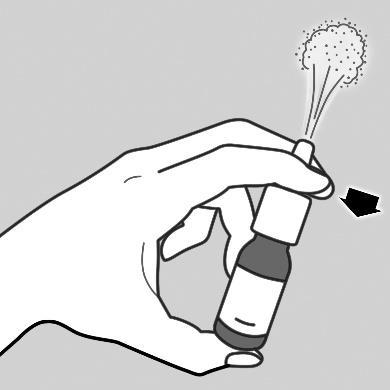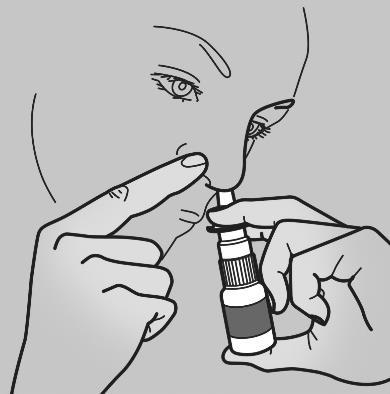
Solafid
Ask a doctor about a prescription for Solafid

How to use Solafid
PATIENT INFORMATION LEAFLET
Leaflet accompanying the packaging: information for the user
Solafid
(137 micrograms + 50 micrograms)/nasal dose
nasal spray, suspension
Azelastine hydrochloride + Fluticasone propionate
Read the leaflet carefully before using the medicine, as it contains important information for the patient.
- Keep this leaflet, you may need to read it again.
- In case of any doubts, consult a doctor or pharmacist.
- This medicine has been prescribed specifically for this person. Do not pass it on to others. The medicine may harm another person, even if their symptoms are the same.
- If the patient experiences any side effects, including any side effects not listed in this leaflet, they should tell their doctor or pharmacist. See section 4.
Table of contents of the leaflet
- 1. What is Solafid and what is it used for
- 2. Important information before using Solafid
- 3. How to use Solafid
- 4. Possible side effects
- 5. How to store Solafid
- 6. Contents of the packaging and other information
1. What is Solafid and what is it used for
Solafid contains two active substances: azelastine hydrochloride and fluticasone propionate.
- Azelastine hydrochloride belongs to a group of medicines called antihistamines. Antihistamines work by preventing the action of substances such as histamine, which the body produces as part of an allergic reaction, and thus reduce the symptoms of allergic rhinitis.
- Fluticasone propionate belongs to a group of medicines called corticosteroids, which reduce inflammation.
Solafid is used to relieve the symptoms of moderate to severe seasonal and perennial allergic rhinitis, if the use of other nasal products containing only an antihistamine or corticosteroid is considered insufficient.
Seasonal and perennial allergic rhinitis is a type of allergic reaction to substances such as plant pollen (hay fever), house dust mites, mold spores, dust, or pet dander.
Solafid relieves allergy symptoms, such as: nasal discharge, postnasal drip, sneezing, itching, and a feeling of nasal congestion.
2. Important information before using Solafid
When not to use Solafid
- if the patient is allergic to azelastine hydrochloride or fluticasone propionate or any of the other ingredients of this medicine (listed in section 6).
Warnings and precautions
Before starting to use Solafid, discuss it with your doctor or pharmacist:
- If the patient has recently undergone nasal surgery.
- If the patient has a nasal infection. Nasal infections should be treated with antibacterial or antifungal medications. Patients who have been treated with medications for a nasal infection may continue to treat their allergy with Solafid.
- If the patient has tuberculosis or an untreated infection.
- If the patient notices a change in vision or has been diagnosed with increased intraocular pressure, glaucoma, and/or cataract. Patients with these conditions will be closely monitored during Solafid treatment.
- If the patient has adrenal gland problems. Caution is advised when switching from systemic steroid therapy to Solafid therapy.
- If the patient has severe liver disease. This increases the risk of systemic side effects.
In these cases, the doctor will decide whether Solafid can be used.
It is essential to take the medicine in the dose prescribed below in section 3 or as recommended by the doctor.
Taking nasal corticosteroids in higher doses than recommended may cause adrenal gland problems, which can lead to weight loss, fatigue, muscle weakness, low blood sugar, increased salt cravings, joint pain, depression, and darker skin pigmentation.
In such cases, the doctor may recommend taking another medicine during periods of stress or planned surgery.
To avoid adrenal gland problems, the doctor may recommend taking the medicine in the smallest dose that will continue to control the symptoms of allergic rhinitis effectively.
If the patient experiences blurred vision or other vision problems, they should contact their doctor.
In case of doubts about whether any of the above situations apply to the patient, they should consult their doctor or pharmacist before starting Solafid treatment.
Children and adolescents
Solafid is not recommended for children under 12 years of age.
In children and adolescents, long-term use of nasal corticosteroids (such as Solafid) may slow down growth rates.
The doctor will regularly check the child's growth and ensure they are taking the medicine in the lowest effective dose.
Solafid and other medicines
Tell your doctor or pharmacist about all medicines you are taking, have recently taken, or might take, including those available without a prescription.
Some medicines may increase the effects of Solafid, and your doctor may recommend close monitoring if you are taking such medicines (including certain HIV medicines: ritonavir, cobicistat, and antifungal medicines: ketoconazole).
If you are taking sedatives or central nervous system depressants, do not use Solafid.
Pregnancy and breastfeeding
If you are pregnant or breastfeeding, think you may be pregnant, or are planning to have a baby, ask your doctor or pharmacist for advice before taking this medicine.
Driving and using machines
Solafid has a minor influence on the ability to drive and use machines.
Very rarely, drowsiness and dizziness may occur, which may be caused by the disease itself or Solafid treatment.
In such cases, do not drive or operate machinery.
Be aware that drinking alcohol may increase these effects.
Solafid contains benzalkonium chloride
This medicine contains 14 micrograms of benzalkonium chloride per spray.
Benzalkonium chloride may cause irritation or swelling inside the nose, especially if used for a long time.
3. How to use Solafid
Always use this medicine exactly as your doctor has told you.
In case of doubts, consult your doctor or pharmacist.
To get the most benefit from the treatment, Solafid must be used regularly.
Avoid contact with the eyes.
Use in adults and adolescents (12 years and older)
Use one spray into each nostril, in the morning and evening.
Use in children under 12 years
Solafid is not recommended for children under 12 years of age.
Use in patients with renal and hepatic impairment
There are no data available on the use of Solafid in patients with renal and hepatic impairment.
Method of administration
Nasal spray.
Read the instructions below carefully and use the medicine only as directed.
INSTRUCTIONS FOR USE
Preparing the spray
- 1. Gently shake the bottle for 5 seconds, moving it up and down, then remove the protective cap.
- 2. If the nasal spray is used for the first time, prime the pump by releasing a dose into the air.
- 3. Prime the pump by placing two fingers on either side of the pump and your thumb on the bottom of the bottle.
- 4. Press and release the pump 6 times, until a fine spray appears (see figure a).

a
- 5. The pump is now primed and ready for use.
- 6. If the nasal spray has not been used for more than 7 days, re-prime the pump by pressing and releasing it once.
Using the spray
- 1. Gently shake the bottle for 5 seconds, moving it up and down, then remove the protective cap.
- 2. Blow your nose to clear your nostrils.
- 3. Tilt your head forward towards your toes. Do not tilt your head back.
- 4. Hold the bottle upright and gently place the tip of the nozzle into one nostril.
- 5. Close the other nostril with your finger, press the pump quickly once, and breathe in gently at the same time (see figure b).

b
- 6. Breathe out through your mouth.
- 7. Repeat the same steps for the other nostril.
- 8. After using the spray, breathe in gently and do not tilt your head back. This will prevent the medicine from going down your throat and causing an unpleasant taste.
- 9. After each use, wipe the nozzle with a clean tissue or cloth and replace the protective cap.
- 10. If the nozzle becomes blocked, do not try to unblock it or use a sharp object to clear it. Wash the nozzle with water.
It is essential to use the dose prescribed by your doctor.
Only use the dose recommended by your doctor.
Duration of treatment
Solafid can be used for a long time.
The duration of treatment should correspond to the period during which allergy symptoms occur.
Using a higher dose of Solafid than recommended
In case of using too much nasal spray, there is a small risk of complications.
Consult your doctor if you have any concerns or if you have been taking a higher dose than recommended for a long time.
If someone, especially a child, accidentally swallows Solafid, seek medical attention immediately.
Missing a dose of Solafid
Use the nasal spray as soon as you remember, and then use the next dose at the usual time.
Do not use a double dose to make up for a missed dose.
Stopping Solafid treatment
Do not stop using Solafid without consulting your doctor, as this may lead to ineffective treatment.
In case of further doubts about using this medicine, consult your doctor or pharmacist.
4. Possible side effects
Like all medicines, Solafid can cause side effects, although not everybody gets them.
Very common side effects (may affect more than 1 in 10 people):
- Nosebleeds
Common side effects (may affect up to 1 in 10 people):
- Headache
- Bitter taste in the mouth, especially if you tilt your head back during nasal spray use. This taste should disappear if you drink a non-alcoholic beverage a few minutes after using the spray
- Unpleasant odor
Uncommon side effects (may affect up to 1 in 100 people):
- Mild irritation inside the nose. This may cause a mild stinging, itching, or sneezing sensation
- Dryness in the nose, cough, dry throat, or throat irritation
Rare side effects (may affect up to 1 in 1,000 people):
- Dry mouth
Very rare side effects (may affect up to 1 in 10,000 people):
- Dizziness or drowsiness
- Cataract, glaucoma, or increased eye pressure, which may cause vision loss and/or eye redness and pain. These side effects have been reported after long-term use of nasal sprays containing fluticasone propionate.
- Skin and nasal mucosa damage
- General feeling of being unwell, tiredness, weakness, or fatigue
- Rash, itching, or redness of the skin, itchy blisters on the skin
- Bronchospasm (narrowing of the airways)
Seek medical attention immediately if you experience any of the following symptoms:
Swelling of the face, lips, tongue, or throat, which may cause difficulty swallowing
and/or breathing, as well as a sudden appearance of a skin rash.These may be symptoms of a severe allergic reaction.
Note: these symptoms are very rare.
Side effects with unknown frequency (frequency cannot be estimated from the available data):
- Blurred vision
- Ulcers on the nasal mucosa
In case of using the medicine in high doses for a long time, systemic side effects may occur (side effects affecting the whole body).
The likelihood of these side effects is much lower when using nasal corticosteroids than when taking oral corticosteroids.
These side effects may vary between patients and after using different corticosteroid medicines (see section 2).
Nasal corticosteroids may affect the normal production of hormones in the body, especially when used for a long time in high doses.
In children and adolescents, these side effects may cause growth retardation.
In rare cases, a decrease in bone density (osteoporosis) has been observed when corticosteroids were used nasally for a long time.
Reporting side effects
If you experience any side effects, including any side effects not listed in this leaflet, tell your doctor or pharmacist.
Side effects can be reported directly to the Department of Drug Safety Monitoring, Office for Registration of Medicinal Products, Medical Devices, and Biocidal Products, Al. Jerozolimskie 181C, 02-222 Warsaw, tel.: +48 22 49 21 301, fax: +48 22 49 21 309, website: https://smz.ezdrowie.gov.pl
Side effects can also be reported to the marketing authorization holder.
By reporting side effects, you can help provide more information on the safety of this medicine.
5. How to store Solafid
Keep this medicine out of the sight and reach of children.
Do not use this medicine after the expiry date stated on the label and carton after EXP.
The expiry date refers to the last day of the month stated.
Do not store in the refrigerator or freeze.
Shelf life after first opening: discard any unused medicine 6 months after opening the nasal spray.
Medicines should not be disposed of via wastewater or household waste.
Ask your pharmacist how to dispose of medicines no longer required.
This will help protect the environment.
6. Contents of the packaging and other information
What Solafid contains
- The active substances are azelastine hydrochloride and fluticasone propionate.
Each gram of suspension contains 1000 micrograms of azelastine hydrochloride and 365 micrograms of fluticasone propionate.
- Other ingredients are disodium edetate, glycerol, microcrystalline cellulose, sodium croscarmellose, polysorbate 80, benzalkonium chloride, phenylethyl alcohol, and purified water.
What Solafid looks like and contents of the pack
Solafid is a white or almost white, homogeneous suspension.
Solafid is available in a brown glass bottle with a pump spray, applicator, and protective cap, in a cardboard box.
The 25 mL bottle contains 23 g of nasal spray suspension (at least 120 doses).
Solafid is available in:
packaging containing 1 bottle of 23 g nasal spray suspension.
Marketing authorization holder and manufacturer
Marketing authorization holder
SUBSTIPHARM
24 rue Erlanger
75016 Paris
France
Manufacturer
FARMEA
10, rue Bouché Thomas
ZAC d’Orgemont
49007 Angers
France
FARMACLAIR
440 Avenue Du Général De Gaulle
14200 Hérouville-Saint-Clair
France
This medicine is authorized in the Member States of the European Economic Area under the following names:
Poland: Solafid
Sweden: Solafid
Date of last revision of the leaflet: 17/04/2025
- Country of registration
- Active substance
- Prescription requiredYes
- ImporterFarmaclair FARMEA
- This information is for reference only and does not constitute medical advice. Always consult a licensed doctor before taking any medication. Oladoctor is not responsible for medical decisions based on this content.
- Alternatives to SolafidDosage form: Aerosol, (137 mcg + 50 mcg)/doseActive substance: fluticasone, combinationsPrescription requiredDosage form: Aerosol, (137 mcg + 50 mcg)/ doseActive substance: fluticasone, combinationsPrescription requiredDosage form: Aerosol, (137 mcg + 50 mcg)/nasal doseActive substance: fluticasone, combinationsPrescription required
Alternatives to Solafid in other countries
The best alternatives with the same active ingredient and therapeutic effect.
Alternative to Solafid in Spain
Alternative to Solafid in Ukraine
Online doctors for Solafid
Discuss dosage, side effects, interactions, contraindications, and prescription renewal for Solafid – subject to medical assessment and local rules.








